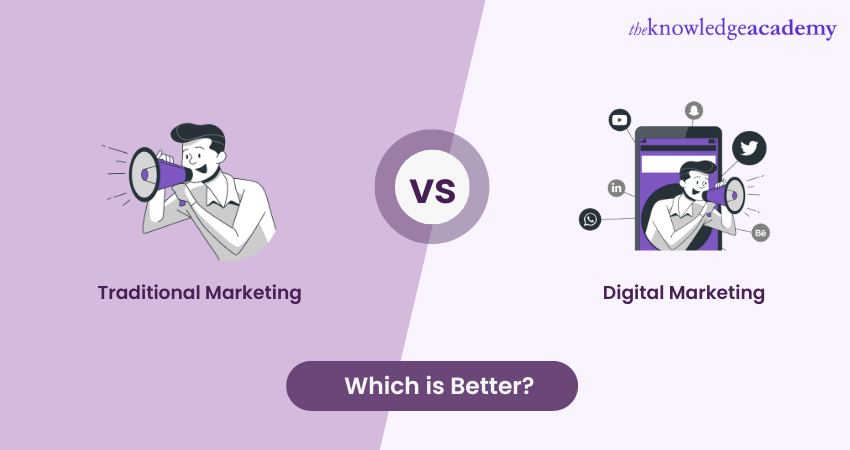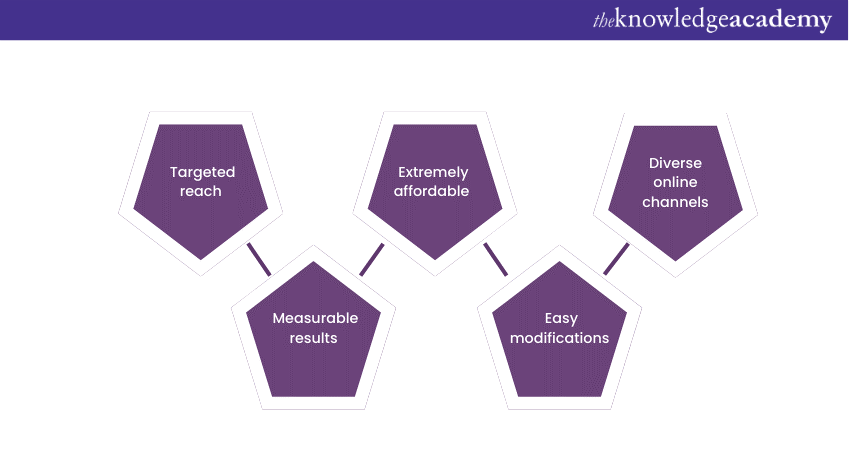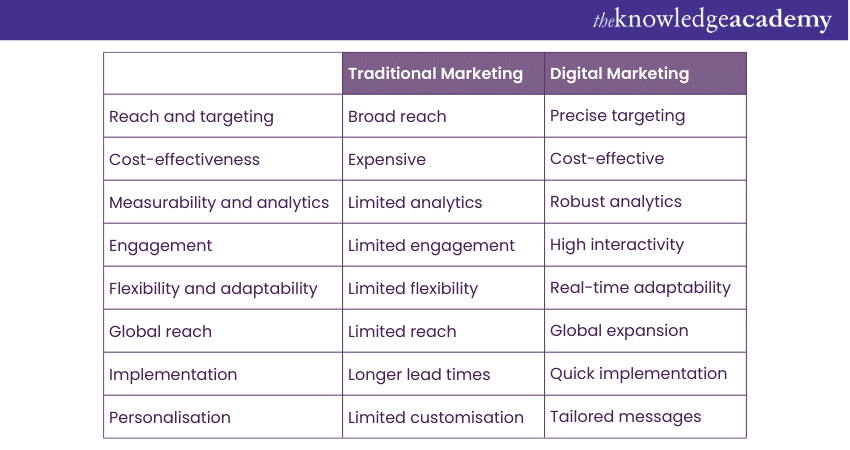We may not have the course you’re looking for. If you enquire or give us a call on 01344203999 and speak to our training experts, we may still be able to help with your training requirements.
Training Outcomes Within Your Budget!
We ensure quality, budget-alignment, and timely delivery by our expert instructors.

The world of marketing is constantly changing, and keeping up with these changes is crucial for businesses. Two prominent approaches that have revolutionised the marketing landscape are Traditional Marketing and Digital Marketing. Thus, learning the difference between Traditional Marketing vs Digital Marketing can help you find out figure out the best approach for you. Explore traditional marketing vs digital marketing, discovering the benefits of each approach for your business. Continue reading to learn more!
According to Statista, the global expenditure for Digital advertising stood at a staggering 446 billion GBP. This statistic demonstrates how technological advances and evolving customer preferences resulted in making the internet the most important medium for Digital Advertising. Thus, it’s crucial to explore the differences between traditional forms of Marketing and learn how the digital age is moving to adopt other forms of advertising. In this blog, you will learn about Digital Marketing vs Traditional Marketing, there features, pros and cons, as well as thier differences in detail.
Table of contents
1) What is Digital Marketing?
2) Forms of Digital Marketing
3) Pros and cons of Digital Marketing
4) What is Traditional Marketing?
5) Forms of Traditional Marketing
6) Pros and Cons of Traditional Marketing
7) Differences between Traditional Marketing vs Digital Marketing
8) Traditional Marketing vs Digital Marketing: Which one is better?
9) How to choose the right Marketing method?
10) Conclusion
What is Digital Marketing?
Digital Marketing refers to the strategic use of technologies and digital channels to promote products, services, or brands to a target audience. It encompasses various online platforms, such as websites, search engines, social media, email, mobile apps, and digital advertising.
In Digital Marketing, businesses leverage digital tools and tactics to reach and engage with their customers in a more targeted and measurable way. The following are the main purposes of Digital Marketing:
1) Build brand awareness
2) Drive website traffic
3) Generate leads
4) Increase conversions
Forms of Digital Marketing
Digital Marketing is a Marketing form that uses digital platforms and channels to reach potential customers and promote products or services. Some of the common types of Digital Marketing are:
1) Social Media Marketing (SMM): This strategy involves creating and sharing creative and engaging content on social media platforms like Instagram, Facebook, Twitter, etc., to attract and interact with the target audience.
2) Email Marketing: This is a way of sending electronic messages to potential or existing customers to inform them about offers, updates, or benefits of the products or services.
3) Content Marketing: This is a strategy of content creation and distributing valuable, relevant, and consistent content to educate, entertain, or persuade the audience.
4) Pay-per-Click or PPC: In this model of online advertising, the advertiser pays the publisher a fee each time someone clicks on their ad. The ads are usually displayed on search engines or websites related to the keywords or topics of the ad.
5) Mobile Marketing: This refers to reaching out to customers through their mobile devices such as tablets, smartphones or laptops. It can include SMS, MMS, push notifications, in-app ads, etc.
6) Search Engine Optimisation (SEO): This is a process of improving the visibility and ranking of a web page or a website on search engines such as Google or Bing. It involves optimising the content, design, and technical aspects of the website to match the search intent and preferences of the users.
7) Affiliate Marketing: This is performance-based Marketing where a business rewards an affiliate (such as an influencer or a blogger) for each customer or sale generated by the affiliate's referral.
Pros and cons of Digital Marketing
Let's explore the various advantages and disadvantages of Digital Marketing:
Pros of Digital Marketing
This medium offers numerous benefits that can contribute to the success of a business as follows:

a) Targeted reach: It allows businesses to target specific audiences based on demographics, interests, and online behaviour. This targeted approach ensures that Marketing efforts are directed towards the most relevant potential customers.
b) Measurable results: Unlike Traditional Marketing, Digital Marketing provides extensive analytics and tracking capabilities. Businesses can examine the performance of their campaigns in real-time and track website traffic, conversions, engagement, and other metrics to assess the effectiveness of their Marketing strategies.
c) Cost-effectiveness: This medium often requires lower financial investments compared to Traditional Marketing channels. Businesses can leverage various digital platforms at affordable costs, such as social media advertising, email Marketing, and content Marketing, making it accessible for businesses of all sizes.
d) Flexibility and agility: This medium allows for quick adjustments and modifications to Marketing campaigns based on real-time data and insights. Businesses can adapt their strategies promptly, optimise their campaigns, and respond to market trends and customer preferences in a more agile manner.
e) Wide range of channels: This medium encompasses a wide range of online channels and platforms, including search engines, social media, email, websites, mobile apps, and more. This diversity provides businesses with multiple avenues to interact and engage with potential customers and increase brand visibility.
Accelerate your online success with our comprehensive Search Engine Marketing (SEM) Training. Sign up now!
Cons of Digital Marketing
While this medium offers significant advantages, it also has certain limitations that businesses should be aware of. Here are the key disadvantages:
a) Digital overload: With the increasing prevalence of Digital Marketing, consumers are constantly exposed to numerous online ads and promotional messages. This saturation can lead to ad fatigue and reduced attention spans, making it challenging for businesses to stand out and capture the audience's attention effectively.
b) Technical expertise required: Implementing and managing Digital Marketing campaigns often requires technical knowledge and expertise. Businesses may need to hire professionals or invest in training to navigate Digital Marketing tools, platforms, and strategies effectively.
c) Digital security and privacy concerns: Digital Marketing involves collecting and storing customer data, which raises concerns about privacy and data security. Businesses must ensure compliance with data protection regulations and take appropriate measures to safeguard customer information.
d) Constantly evolving landscape: Digital Marketing trends and technologies are constantly evolving. Staying updated with the latest developments and emerging platforms can be challenging for businesses, requiring continuous learning and adaptation to remain competitive.
e) Dependency on technology: Digital Marketing heavily relies on technology infrastructure and platforms. Technical issues, server outages, or changes in algorithms can impact the visibility and performance of Digital Marketing campaigns.
What is Traditional Marketing?
Traditional Marketing refers to the conventional methods and practices used by businesses to promote their products or services before the rise of digital technology. It involves offline channels and physical mediums to reach and engage with the target audience.
Forms of Traditional Marketing
Traditional Marketing uses conventional media and methods to reach potential customers and promote products or services. Some of the common types of Traditional Marketing are:
1) Television Commercials: These are short video clips that are broadcasted on TV channels during breaks or intervals. They are designed to capture the attention and interest of the viewers and persuade them to buy the products or services.
2) Radio Commercials: These are audio messages that are aired on radio stations during programs or segments. They are meant to appeal to the listeners and influence their buying decisions.
3) Flyers: These are printed materials that are distributed by hand or by mail to potential customers in a specific area or location. They usually contain information about the products, services, offers, or events of the business.
4) Billboards: These are large outdoor signs that are placed on roadsides or buildings. They display images or texts that advertise the products or services of the business. They aim to create awareness and recognition among the passers-by.
5) Magazine and Newspaper Ads: These are printed advertisements that are published in magazines or newspapers that cater to a particular niche or audience. They can include images, texts, logos, or slogans that highlight the features or benefits of the products or services.
6) Telephone and SMS Marketing: These involve contacting potential or existing customers by phone calls or text messages to inform them about the products, services, offers, or feedback of the business.
7) Referral: This is word-of-mouth Marketing where the business asks its customers or employees to recommend its products or services to their friends, family, or neighbours.
8) Direct Mail: This is a form of Postal Marketing where the business sends personalised letters, postcards, brochures, catalogues, or coupons to potential or existing customers in a specific area or segment.
Pros and Cons of Traditional Marketing
Traditional Marketing, with its historical significance, brings forth a range of advantages and disadvantages. Let's dive into the pros and cons of Traditional Marketing:
Pros of Traditional Marketing
Traditional Marketing methods offer several benefits that businesses can leverage to reach their target audience effectively. Here are the key advantages:
a) Wide reach: Traditional Marketing enables businesses to connect with a broad audience, including those who may not have access to digital platforms. Television, radio, and print media have a wide reach and can effectively target diverse demographics.
b) Tangibility: Traditional Marketing relies on physical materials like Brochures, Flyers, and Billboards, providing a tangible presence for customers. These materials can be seen, touched, and kept for future reference, enhancing brand visibility and recall.
c) Established credibility: Traditional Marketing holds a long-standing history and familiarity with consumers. Well-established brands and businesses that have successfully utilised Traditional Marketing can build credibility and trust among their target audience.
d) Local targeting: Traditional Marketing allows for effective local targeting, making it suitable for businesses operating in specific geographical areas. Local newspapers, radio stations, and community events can efficiently reach the target audience in a particular location.
e) Personal interaction: Some Traditional Marketing techniques, such as telemarketing or face-to-face interactions at events and trade shows, enable direct personal interactions with potential customers. This personal touch helps build relationships and address customer inquiries more effectively.
Cons of Traditional Marketing
While Traditional Marketing brings benefits, it also faces certain limitations that businesses need to consider. Here are the key disadvantages:
a) Limited analytics: Traditional Marketing lacks the advanced analytics and tracking capabilities available in Digital Marketing. Accurately measuring the precise impact and Return on Investment (ROI) of Traditional Marketing campaigns can be challenging.
b) Higher costs: Traditional Marketing methods often require significant financial investments. Television and radio advertisements, print media placements, and billboards can be costly, especially for small businesses with limited budgets.
c) A less targeted approach: Traditional Marketing offers less precise targeting options compared to Digital Marketing. Reaching a specific niche audience or tailoring messages to individual preferences can be more challenging with traditional methods.
d) Limited interactivity: Traditional Marketing typically functions as a one-way communication channel, offering limited opportunities for immediate interaction and engagement from the audience. It lacks the interactive and real-time nature of Digital Marketing platforms.
e) Slow response time: Traditional Marketing campaigns often necessitate longer lead times from planning to execution. Making changes or adjustments to strategies or materials may require more time and effort, limiting the agility and responsiveness of marketing campaigns.
Businesses should consider these advantages and disadvantages when formulating their marketing strategies. While Traditional Marketing has its merits, Digital Marketing offers new opportunities for targeted reach, precise analytics, and interactive engagement with the audience.
Differences between Traditional Marketing vs Digital Marketing
There are several key differences between Traditional Marketing and Digital Marketing respectively. Let's explore these two marketing approaches below:

Reach and targeting
Traditional Marketing primarily focuses on mass reach through offline channels like television, radio, and print media. Targeting is often broader, aiming to reach a wide audience without precise customisation.
In contrast, Digital Marketing enables precise targeting based on various factors such as demographics, interests, behaviour, and online activities. It allows businesses to reach specific niche audiences and personalise marketing messages.
Cost effectiveness
Traditional Marketing campaigns can be expensive, especially for television advertisements, print media, and billboards. Production, distribution, and placement costs contribute to higher expenses.
On the othe hand, Digital Marketing offers cost-effective options such as Pay-Per-Click (PPC) advertising, social media marketing, and email marketing. Businesses can allocate budgets based on their needs and measure the return on investment more accurately.
Unlock the secrets to cost optimisation and maximise your Digital Marketing ROI with our exclusive Cost Optimisation Masterclass. Sign up now!
Measurability and analytics
Traditional Marketing lacks accurate measurement and precise analytics. It can be challenging to find the impact of campaigns accurately, making it harder to evaluate the effectiveness of specific marketing efforts.
In contrast, Digital Marketing provides robust analytics tools, allowing businesses to measure and track various metrics such as website traffic, engagement rates, conversion rates, and customer behaviour. This data-driven approach enables precise analysis and optimisation of marketing strategies.
Interactivity and engagement
Traditional Marketing methods offer limited interactivity and engagement with the audience. It relies on one-way communication, where customers have minimal opportunities to interact with the marketing message or provide immediate feedback.
On the contray, Digital Marketing thrives on interactivity and engagement. Social media platforms, interactive content, and personalised communication channels enable businesses to interact directly with customers, encourage engagement, and build relationships.
Flexibility and adaptability
Traditional Marketing campaigns often require substantial lead times and lack flexibility once executed. Modifications or adjustments can be challenging and costly, limiting the ability to respond quickly to market changes.
On the other hand, Digital Marketing offers flexibility and adaptability. Campaigns can be modified, optimised, and adjusted in real time based on performance data and market trends. Changes can be implemented swiftly, allowing businesses to stay agile and responsive.
Global reach and audience coverage
Traditional Marketing campaigns generally have limited geographical reach. Local newspapers, radio stations, and physical mediums confine the audience scope.
Digital Marketing breaks geographical barriers, allowing businesses to reach a global audience. Through Search Engine Optimisation (SEO), online advertising, and social media, companies can increase their customer base beyond local markets.
Quick implementation and results
Traditional Marketing campaigns often require longer lead times for planning, production, and distribution. It may take weeks or even months before seeing tangible results from the marketing efforts.
Opposed to that, Digital Marketing campaigns can be implemented quickly, sometimes within hours. Social media posts, online advertisements, and email campaigns can reach the target audience almost instantly. This speed allows businesses to seize time-sensitive opportunities and achieve faster results.
Understanding these key differences between Traditional Marketing and Digital Marketing is crucial for businesses to make informed decisions when developing their marketing strategies. While traditional methods of marketing still have their place, Digital Marketing provides unparalleled targeting capabilities, measurability, interactivity, and global reach in the modern marketing landscape.
Traditional Marketing vs Digital Marketing. Which one is better?
The best choice between Traditional Marketing and Digital Marketing depends on various factors. These are as follows:
Digital Marketing is likely the preferred option for most businesses willing to reach all types of audience, from teenagers to old-aged people. It allows them to target a specific group of people, wherever they are, and keep your costs low. It also enables businesses to get instant feedback on their audience and create more effective marketing campaigns.
However, Traditional Marketing still has some advantages. It may be more suitable for reaching an older or local audience, who may not be as exposed to Digital Marketing methods. These methods may seem outdated, but they have survived for a reason.
To decide which Marketing strategy is best for your business, you need to understand your audience and where they get their information from. When comparing Traditional vs Digital Marketing, there is no clear winner as they have different purposes. The most important thing is that you know your business and your audience well enough to pick the strategy that suits you best.
How to choose the right Marketing method?
Digital Marketing has the advantage of being more affordable and more specific, while Traditional Marketing can reach a wider audience more effectively. You need to think about your budget and target market when choosing the right marketing method for your business.
The best Marketing method is the one that fits your business and your objectives
Conclusion
We hope that you have read and understand everything about Traditional Marketing vs Digital Marketing. Both these methods should be viewed as complementary strategies, each offering unique advantages in reaching and engaging customers. By harnessing the power of both approaches, businesses can create holistic marketing campaigns that drive success.
Elevate your marketing game and conquer the digital landscape with our cutting-edge Digital Marketing Courses.
Frequently Asked Questions
Upcoming Digital Marketing Resources Batches & Dates
Date
 Digital Marketing Course
Digital Marketing Course
Fri 19th Jul 2024
Fri 20th Sep 2024
Fri 15th Nov 2024







 Top Rated Course
Top Rated Course




 If you wish to make any changes to your course, please
If you wish to make any changes to your course, please


